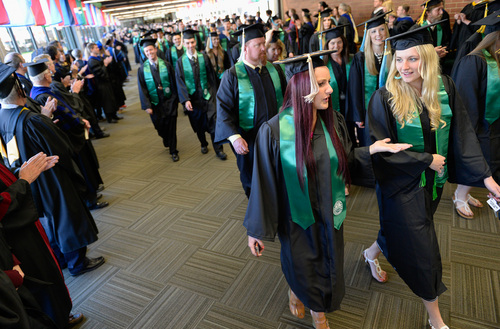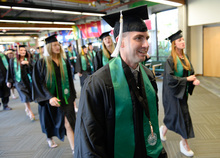This is an archived article that was published on sltrib.com in 2014, and information in the article may be outdated. It is provided only for personal research purposes and may not be reprinted.
Utah Valley University graduated the largest class in its history Thursday, sending a bumper crop of recession-era students from the rapidly growing county into the world.
"It's a perfect storm in a positive sense," said UVU President Matthew Holland. Most of the 5,258 students who got their diplomas Thursday enrolled at a time when the state's public university system posted record enrollment gains as people who lost jobs or couldn't get them went to school.
The growth also coincided with the school's shift to university status in 2008, a move that meant more students stayed through graduation rather than transfer to other schools.
"Historically we've been a transfer institution," Holland said. Founded in 1941 as a vocational school to train World War II production workers, UVU was a community college until the 1990s and remains an open-enrollment institution.
"The biggest growth is not from new freshmen but rather from juniors and seniors," Holland said. "Now people are saying, 'We love the programs ... we want to stay.' "
The six-year graduation rate, though, was still about 24 percent in 2013, the most recent year for which numbers are available, and UVU's class of 2014 was still significantly smaller than the University of Utah's graduate count of nearly 8,000 students.
Enrollment at the school, which is located in a heavily Mormon area, took a fairly large hit when The Church of Jesus Christ of Latter-day Saints lowered age requirements for its missionaries, but demographics point to a future boom: Utah County is home to some of the fastest-growing cities in the state, which itself has one of the most rapidly expanding populations in the country.
Maybe it's no surprise, then, that higher-education bosses expect UVU to grow faster than any other institution in the state in coming years.
"My sense is that we'll probably grow again next year," Holland said. "At some point, we'll probably run into that missionary dip, but I think the trend will be building for the next few years rather than going in the other direction. We're looking for that continued climb."
Twitter: @lwhitehurst









